
Avogadro's law units of measurement and experiment
The Avogadro's law postulates that an equal volume of all gases, at the same temperature and pressure, has the same number of molecules. Amadeo Avogadro, an Italian physicist, proposed two hypotheses in 1811: the first says that the atoms of elemental gases are together in molecules instead of existing as separate atoms, as John Dalton said..
The second hypothesis says that equal volumes of gases at constant pressure and temperature have the same number of molecules. Avogadro's hypothesis related to the number of molecules in gases was not accepted until 1858, when the Italian chemist Stanislao Cannizaro built a logical system of chemistry based on this.
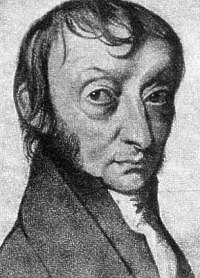
The following can be deduced from Avogadro's law: for a given mass of an ideal gas, its volume and the number of molecules are directly proportional if the temperature and pressure are constant. This also implies that the molar volume of gases that behave ideally is the same for all.
For example, given a number of balloons, labeled A through Z, they are all filled until they are inflated to a volume of 5 liters. Each letter corresponds to a different gaseous species; that is, its molecules have their own characteristics. Avogadro's law states that all balloons house the same number of molecules.
If the balloons are now inflated to 10 liters, according to Avogadro's hypotheses, twice the number of initial gaseous moles will have been introduced.
Article index
- 1 What it consists of and units of measurement
- 1.1 Deduction of the value of R when it is expressed in L atm / K mol
- 2 Usual form of Avogadro's law
- 3 Consequences and implications
- 4 Origins
- 4.1 Avogadro's hypothesis
- 4.2 Avogadro's number
- 5 Avogadro's experiment
- 5.1 Experiment with commercial containers
- 6 Examples
- 6.1 O2 + 2H2 => 2H2O
- 6.2 N2 + 3H2 => 2NH3
- 6.3 N2 + O2 => 2NO
- 7 References
What it consists of and units of measurement
Avogadro's law states that, for a mass of an ideal gas, the volume of the gas and the number of moles are directly proportional if the temperature and pressure are constant. Mathematically it can be expressed with the following equation:
V / n = K
V = volume of gas, generally expressed in liters.
n = amount of the substance measured in moles.
Also, from the so-called ideal gas law we have the following:
PV = nRT
P = gas pressure is usually expressed in atmospheres (atm), in mm of mercury (mmHg) or in Pascal (Pa).
V = the volume of the gas expressed in liters (L).
n = number of moles.
T = the temperature of the gas expressed in degrees Celsius, degrees Fahrenheit or degrees Kelvin (0 ºC equals 273.15K).
R = the universal constant of ideal gases, which can be expressed in several units, among which the following stand out: 0.08205 L atm / K. mol (L atm K-1.mole-1); 8.314 J / K. mol (J.K-1.mole-1) (J is joule); and 1,987 cal / Kmol (cal.K-1.mole-1) (cal is calories).
Deduction of the value of R when expressed in LAtm / KMole
The volume that a mole of a gas occupies at an atmosphere of pressure and 0 ºC equivalent to 273K is 22.414 liters.
R = PV / T
R = 1 atm x 22,414 (L / mol) / (273 ºK)
R = 0.082 L atm / mol.K
The ideal gas equation (PV = nRT) can be written as follows:
V / n = RT / P
If temperature and pressure are assumed to be constant, because R is a constant, then:
RT / P = K
Later:
V / n = K
This is a consequence of Avogadro's law: the existence of a constant relationship between the volume that an ideal gas occupies and the number of moles of that gas, for a constant temperature and pressure..
Usual form of Avogadro's law
If you have two gases, then the previous equation becomes the following:
V1/ n1= Vtwo/ ntwo
This expression is also written as:
V1/ Vtwo= n1/ ntwo
The above shows the indicated proportionality relationship.
In his hypothesis, Avogadro pointed out that two ideal gases in the same volume and at the same temperature and pressure contain the same number of molecules..
By extension, the same is true of real gases; for example, an equal volume of Otwo and Ntwo contains the same number of molecules when it is at the same temperature and pressure.
Real gases show small deviations from ideal behavior. However, Avogadro's law is approximately valid for real gases at low enough pressure and at high temperatures.
Consequences and implications
The most significant consequence of Avogadro's law is that the constant R for ideal gases has the same value for all gases.
R = PV / nT
So if R is constant for two gases:
P1V1/ nT1= PtwoVtwo/ ntwoTtwo = constant
Suffixes 1 and 2 represent two different ideal gases. The conclusion is that the ideal gas constant for 1 mole of a gas is independent of the nature of the gas. Then, the volume occupied by this amount of gas at a given temperature and pressure will always be the same.
A consequence of the application of Avogadro's law is the finding that 1 mole of a gas occupies a volume of 22,414 liters at a pressure of 1 atmosphere and at a temperature of 0 ºC (273K).
Another obvious consequence is the following: if pressure and temperature are constant, when the quantity of a gas is increased its volume will also increase..
origins
In 1811 Avogadro put forward his hypothesis based on Dalton's atomic theory and Gay-Lussac's law on the vectors of motion of molecules..
Gay-Lussac concluded in 1809 that "gases, in whatever proportions they can be combined, always give rise to compounds whose elements measured in volume are always multiples of another".
The same author also showed that "gas combinations always take place according to very simple relationships in volume".
Avogadro pointed out that chemical reactions in the gas phase involve molecular species of both reactants and product.
According to this statement, the relationship between the reactant and product molecules must be an integer number, since the existence of bond breakage prior to the reaction (individual atoms) is not likely. However, molar quantities can be expressed with fractional values.
For its part, the law of combination volumes indicates that the numerical relationship between the gaseous volumes is also simple and integer. This results in a direct association between the volumes and the number of molecules of the gaseous species..
Avogadro hypothesis
Avogadro proposed that gas molecules were diatomic. This explained how two volumes of molecular hydrogen combine with one volume of molecular oxygen to give two volumes of water..
Furthermore, Avogadro proposed that if equal volumes of gases contained the same number of particles, the relationship between the densities of the gases should be equal to the relationship between the molecular masses of these particles..
Obviously, dividing d1 by d2 gives rise to the quotient m1 / m2, since the volume occupied by the gaseous masses is the same for both species and it cancels:
d1 / d2 = (m1 / V) / (m2 / V)
d1 / d2 = m1 / m2
Avogadro's number
One mole contains 6.022 x 102. 3 molecules or atoms. This figure is called Avogadro's number, although he was not the one who calculated it. Jean Pierre, 1926 Nobel Prize winner, made the corresponding measurements and suggested the name in honor of Avogadro.
Avogadro's experiment
A very simple demonstration of Avogadro's law consists of placing acetic acid in a glass bottle and then adding sodium bicarbonate, closing the mouth of the bottle with a balloon that prevents the entry or exit of a gas from inside the bottle.
Acetic acid reacts with sodium bicarbonate, thus releasing COtwo. The gas accumulates in the balloon causing its inflation. Theoretically, the volume reached by the balloon is proportional to the number of CO moleculestwo, as stated by Avogadro's law.
However, this experiment has a limitation: the balloon is an elastic body; therefore, as its wall stretches due to the accumulation of COtwo, a force is generated in this that opposes its distension and tries to reduce the volume of the balloon.
Experiment with commercial containers
Another illustrative experiment of Avogadro's law is presented with the use of soda cans and plastic bottles..
In the case of soda cans, baking soda is poured into it and then a citric acid solution is added. The compounds react with each other producing the release of CO gastwo, which accumulates inside the can.
Subsequently, a concentrated sodium hydroxide solution is added, which has the function of "sequestering" the CO.two. Access to the inside of the can is then quickly closed by using masking tape.
After a certain time, it is observed that the can contracts, indicating that the presence of CO has decreased.two. Then, it could be thought that there is a decrease in the volume of the can that corresponds to a decrease in the number of CO molecules.two, according to Avogadro's law.
In the experiment with the bottle, the same procedure is followed as with the soda can, and when the NaOH is added, the mouth of the bottle is closed with the lid; likewise, a contraction of the wall of the bottle is observed. As a result, the same analysis can be performed as in the case of the soda can..
Examples
The three images below illustrate the concept of Avogadro's law, relating the volume that gases occupy and the number of molecules of reactants and products..
ORtwo + 2Htwo => 2HtwoOR
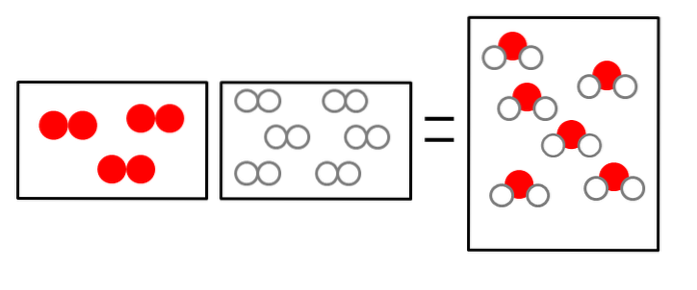
The volume of hydrogen gas is double, but it occupies a container the same size as that of gaseous oxygen.
Ntwo + 3Htwo => 2NH3
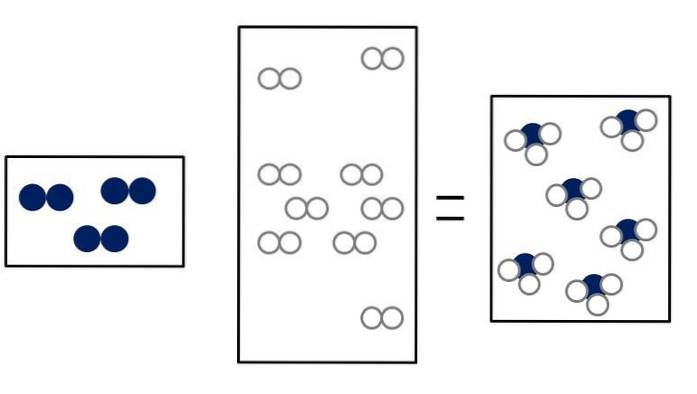
Ntwo + ORtwo => 2NO

References
- Bernard Fernandez, PhD. (February 2009). Two Hypotheses of Avogadro (1811). [PDF]. Taken from: bibnum.education.fr
- Nuria Martínez Medina. (July 5, 2012). Avogadro, the great Italian scientist of the 19th century. Taken from: rtve.es
- Muñoz R. and Bertomeu Sánchez J.R. (2003) The history of science in textbooks: Avogadro's hypothesis, Teaching science, 21 (1), 147-161.
- Helmenstine, Anne Marie, Ph.D. (February 1, 2018). What Is Avogadro's Law? Taken from: thoughtco.com
- The Editors of Encyclopaedia Britannica. (2016, October 26). Avogadro's law. Encyclopædia Britannica. Taken from: britannica.com
- Yang, S. P. (2002). Household products used to collapse close containers and demonstrate Avogadro's Law. Chem. Educator. Vol: 7, pages: 37-39.
- Glasstone, S. (1968). Treaty of Physical Chemistry. twogives Ed. Editorial Aguilar.

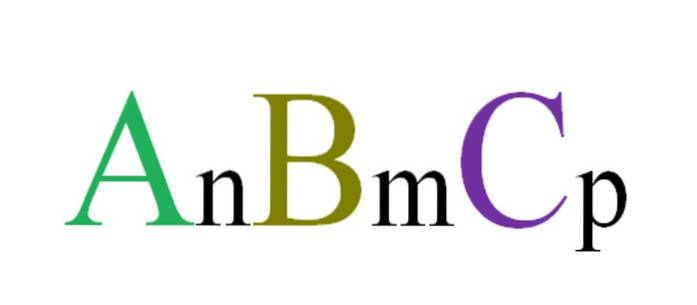
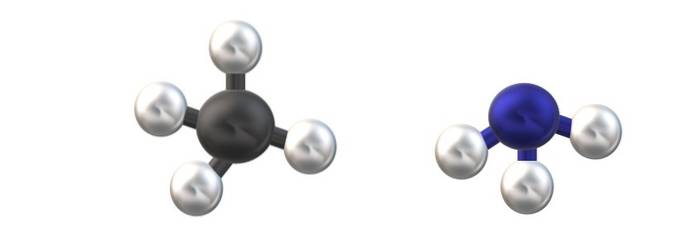
Yet No Comments